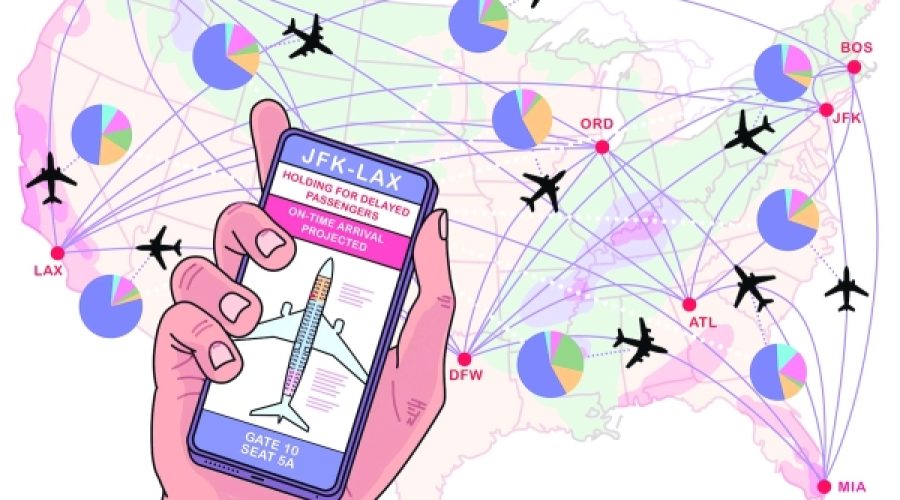How AI is Revolutionizing Air Travel: Implications for Business Efficiency and Connectivity
AI Innovations Transforming Air Travel
Last month in Chicago, a United Airlines flight to London was poised to depart but was held up, waiting for 13 passengers connecting from Costa Rica who were expected to arrive just seven minutes late. Typically, such delays require passengers to rebook, but with the introduction of an AI-driven tool called ConnectionSaver, the flight was able to wait for the passengers and their checked luggage without compromising its timely arrival in London. The system also provided timely text updates to both the late passengers and those on board.
While AI might not yet assist with carry-on luggage, it shows potential to alleviate the frantic rush to catch connecting flights—a scenario familiar to many travelers. United isn’t alone in this innovation; Alaska Airlines, American Airlines, and others are also leveraging AI to enhance passenger experiences and improve operational efficiencies, including fuel savings. Analyst Helane Becker from TD Cowen remarked that while many airlines are independently developing their technologies, successful innovations could quickly become industry-wide standards.
AI is set to revolutionize multiple aspects of air travel, from baggage tracking to personalized entertainment, according to Jitender Mohan, a consultant with WNS.
Enhancing Fuel Efficiency and Reducing Delays
Since 2021, Alaska Airlines has utilized AI to assist dispatchers in planning more efficient flight routes. Vikram Baskaran, the carrier’s VP for IT services, described the AI tool as akin to “Google Maps in the air.” Roughly two hours before departure, it assesses weather conditions, restricted airspace, and all scheduled flights to determine the optimal route. According to Pasha Saleh, Alaska’s corporate development director, this technology processes vast amounts of data far beyond human capabilities.
In 2023, approximately 25% of Alaska flights implemented this system, resulting in time savings of about 41,000 minutes and the conservation of roughly half a million gallons of fuel.
Meanwhile, American Airlines is developing an AI system named Smart Gating, which directs arriving aircraft to the nearest available gate with the shortest taxiing time. Introduced at Dallas Fort Worth International Airport in 2021 and now operational at six locations including Chicago O’Hare, this innovation helps reduce tarmac waiting times, saving an estimated 1.4 million gallons of fuel annually.
Mohan noted that AI’s role as a virtual parking attendant could cut taxiing times by up to 20%, particularly benefiting larger airports.
Improved Customer Communication
The rapid progress in generative AI—similar to platforms like ChatGPT—is enhancing airlines’ ability to communicate effectively with passengers. At United, a recent initiative aimed to create tailored messages regarding flight delays. Passengers who experienced delays, like one from San Francisco to Tucson, received detailed updates about affected aircraft due to runway construction, which reassured them of the airline’s handling of the situation.
Jamie Larounis, a frequent traveler, emphasized the importance of receiving clear explanations during delays, stating it fostered a sense of control.
Additionally, Alaska Airlines has adopted AI to streamline customer service by summarizing inquiries and prioritizing urgent requests, such as those related to upcoming flights. This system aids human agents by suggesting responses and drafting initial replies while allowing agents to make final decisions.
Despite the promising benefits of AI for airlines and their customers, challenges remain. For instance, in 2022, an Air Canada chatbot mistakenly assured a traveler of a bereavement fare, leading to a minor legal dispute that underscored the necessity for reliable AI performance.
As technological advancements continue, airlines are racing to implement innovative AI solutions, promising increasingly seamless experiences for passengers. Jitender Mohan remarked, “This is one of the biggest technological disruptions in the last five to eight years.”
Special Analysis by Omanet | Navigate Oman’s Market
The rise of AI in the airline industry signifies a transformative opportunity for businesses in Oman, particularly those in the travel and hospitality sectors. With airlines streamlining operations and enhancing customer service through AI technologies, stakeholders should consider investing in AI-driven solutions to improve efficiency and customer satisfaction. However, the potential for miscommunication and inaccuracies also presents a risk; businesses must mitigate these challenges to maintain customer trust and loyalty.



